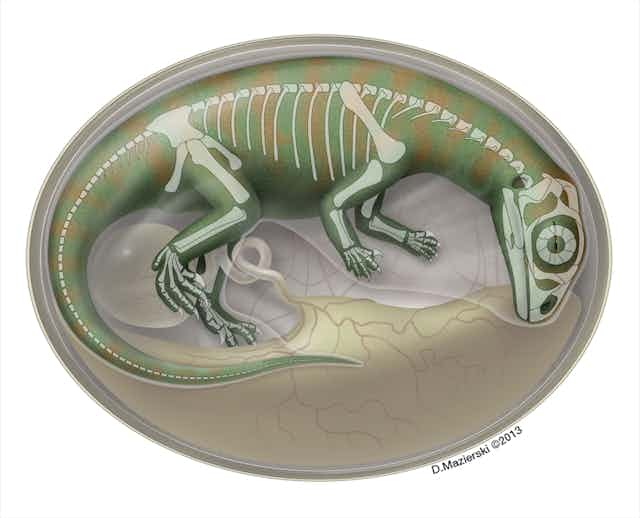We should forget about ever finding something as small and delicate as a dinosaur embryo, right? A few months ago I would have agreed – but now, well, things have changed.
When my colleague, palaeontologist Robert Reisz from the University of Toronto, asked me in late 2011 to accompany his team of Canadian, Taiwanese, and Chinese scientists on a project in Yunnan, China to investigate a new site with hundreds of what he thought might be embryonic dinosaur bones, I quickly packed my bags.
This morning, we published our preliminary findings, which provide some of the first clues about how sauropodomorph dinosaurs, a group that includes the largest terrestrial animals to ever live, managed to achieve such gigantic proportions.

Among a well of new revelations, we found that growth rates within the egg were extremely rapid, probably facilitating very short incubation periods — faster than that of extant birds or other dinosaurs.
The embryos’ fast muscle growth also meant they were quite active while still in the egg.
This is a trait that probably continued through the animals’ lifetime, allowing them to achieve such great sizes.
But taking these first steps towards developing the field of dinosaur embryology wasn’t something I thought would ever be possible given my expectations of the fossil record.
What are the odds of becoming a fossil?
Palaeontologists are often asked what percentage of animals actually get fossilised.
It’s difficult to estimate, but the simple answer is: very, very few – particularly if they don’t live in the water.
Over the past 375 million years or so, since vertebrates first moved on to dry land, millions of animals must have lived and died on just about every square inch of every continent.

But becoming a fossil is like winning the lottery – a one-in-a-million chance.
To put this another way, of the nearly 5 million people currently living in Queensland, four or five might just become a fossil one day.
As a sedimentary geologist (someone who studies dirt, according to a few of my students), I specialise in studying terrestrial ecosystems from the Mesozoic Era – the “Age of Dinosaurs”.
I spend a lot of time in the field looking at rocks that should be full of fossils, but aren’t.
Dinosaur embryos
Dinosaur eggs and nests are actually pretty common, as far as things go; but preserving embryos within the fossil eggs is not.
Worldwide, only a handful of dinosaur nest sites contain eggs with well-preserved embryos.
Even so, you might wonder why embryologic investigations have not already been done.
But if you found a dinosaur nest with eggs containing remarkably preserved baby dinosaurs, how willing would you be to destroy the nests and eggs to study them in this way?

You would need to permanently dismantle the fossilised nests, then the eggs, and finally the skeletons, to collect individual bones to grind down into wafer-thin sections to glue on microscope slides in order to study the patterns of bone growth and development.
This is crucial if you want to understand anything about embryological development in a 200-million-year-old extinct organism.
More problematic, you would then need to do this with individuals from different nests at progressive stages of development. You get my drift …
Inside the bonebed
What sets this new discovery apart and opens the door to investigating dinosaur embryology is the fact that the site did not preserve a series of beautiful nests containing eggs with embryos.
It represented an accumulation, or what we call a “bonebed”, of many embryonic bones that somehow became disassociated from their nests and eggs, and then concentrated together into a single mass not much bigger than my laptop computer.
The bones are ridiculously tiny - most less than a centimetre long - and made up of disarticulated bones of different sizes, representing the remains of embryonic dinosaurs that can only have come from individuals that were originally from a variety of different nests laid at slightly different times (likely on the scale of days to weeks apart).

We managed to excavate more than 200 disarticulated bones, representing dozens of animals in varying stages of embryonic development.
Careful investigation of the site suggested this remarkable fossil deposit formed when a colony of prosauropods (sauropods’ older cousins) nested in a low-relief floodplain, which was subsequently flooded and abandoned.
As the eggs decayed, the embryos began to break apart and gentle waves and currents washed the bones and broken eggs from the various nests into the bonebed.
The bones were then slowly buried as the flood waters receded, leading to a near-perfect scenario for investigating embryonic development within a species (Lufengosaurus) of early dinosaurs.
Such bonebeds are very rarely discovered - this may be the first of its kind - but now we may recognise other embryonic bones and bonebeds to further fill in gaps in dinosaur evolution.
In the case of the embryos we discovered, it’s patently clear they didn’t grow to a stage where they could flee the nest and live fruitful lives – but thanks to them the study of dinosaur embryology has a chance of maturing and thriving in the years ahead.

